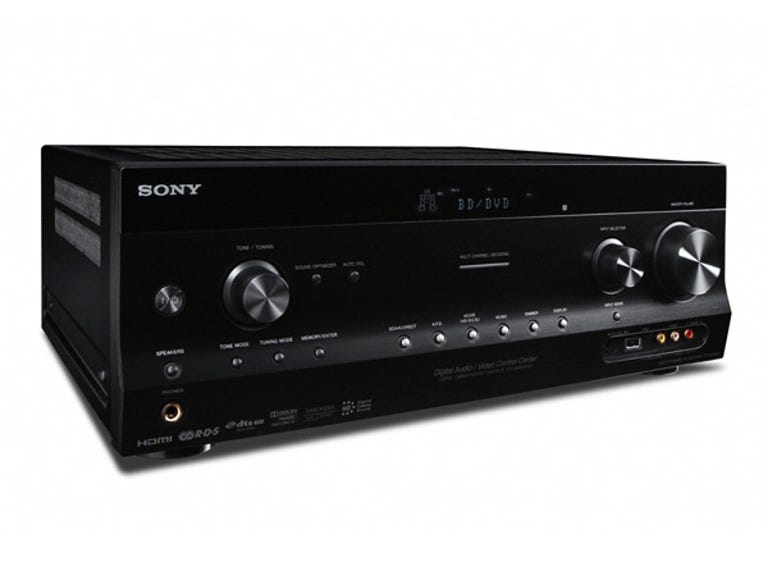 Why You Can Trust CNET
Why You Can Trust CNET Sony STR-DN1020 review: Sony STR-DN1020
Low in cost and reasonable in performance, the Sony STR-DN1020 home-theatre receiver does a decent job on the basics. However, its USB/DLNA/internet radio/iPod offerings are hobbled by a lousy interface.
Connections
Sony is largely standard on the connection front. As is increasingly common, S-Video has been abandoned. There are two subwoofer outputs, which Sony takes as licence to call this a "7.2-channel" receiver. It isn't; it's 7.1, because the two subwoofer outputs carry the same signal.
The Good
The Bad
The Bottom Line
There is one HDMI output (supporting Audio Return Channel), which is plenty in most installations, but only four HDMI inputs — which is so 2009 — but none on the front panel. But you do get Ethernet, with USB at the front.
Set-up
Plug in the supplied calibration microphone, put it where your head would normally be and press the appropriate buttons. In an extremely short time, the unit will have calculated your system's settings, and applied them. These adjustments are not just to such things as speaker levels, distances and sizes, but also equalisation of the speakers. Oddly, this EQ can't be switched on and off later, so you should select "Custom" as the calibration mode, and then select whether or not you want EQ (and the type you want, as explained in the manual) before you start the calibration.
Sound
We're a bit reluctant to report on the power-output claims, thanks to Sony's lo-fi specification. Most brands report on the full audio bandwidth (20-20,000Hz), with distortion levels of under 0.1 per cent. Sony claims 100 watts per channel into 8 ohms at 1kHz, and 1 per cent total harmonic distortion. In surround mode, it claims 140 watts with the same criteria, except for the distortion, which is a dreadful 10 per cent.
After setting up, dig around in the menus a bit. Under Settings: Speaker, you'll find that Dynamic Range Compression has been set to "Auto". This means that some Blu-ray discs (it doesn't affect DVDs) will have their dynamic range compressed. But not all, and the results are unpredictable. It's generally best to change this to "Off".
There is a "Sound Optimiser" key on the remote that invokes a process designed to make the sound better at low-volume levels. If by "better" they mean lumpy and unnatural, then feel free to use it.
The default EQ setting was labelled "Engineer" in the Custom set-up. We thought that this was also a bit lumpy (the mid bass was rather prominent, and a touch boxy). Rerunning with "Full Flat" did the trick, producing a more neutral and natural sound.
On a middling speaker set with good overall performance, the levels able to be delivered by the receiver were good, if just a bit harsh at the highest levels.
Video
There really isn't much to say about this unit's video performance, other than that it passes through everything it is supposed to, including the frame packed format from Blu-ray 3D. It does not upscale HDMI input, although it does analog-video input if you still have such devices. The results weren't very pretty, with the composite input and 1080p output. The picture was very soft and flickery, with poor progressive scan conversion.
The unit has a clean and attractive onscreen display. This does not overlay the source's video, but replaces it.
iPod, etc
The USB input supports MP3, WMA and AAC variants, but the interface was limited. Press "Play", and it will play the first track it finds on the USB drive, and then you can skip track to track, or folder to folder, but at no point can you simply list contents for selection.
For your iPod/iPhone etc, you will need an optional USB/Composite Video cable from Apple, because the device's menu system is delivered by analog video rather than over USB. The advantage of that is that you can also watch videos from your iPod, but delivered in SD at best from composite video generally doesn't make for a great look. There was no fast way of scrolling through lists of artists and whatnot, nor a search facility. You will find yourself neglecting artists whose names start with letters far from "A".
Sony's MediaRemote iPhone app recognised the existence of the receiver, but it demanded a registration with the unit on a panel that didn't seem to be provided by the unit.
You get internet radio via vTuner, but a fairly horrible interface. It only lists two stations at a time, and each station was displayed with only twelve characters, requiring horizontal scrolling after a pause.
There was no useable acceleration method for long lists. And, believe me, the lists of internet radio stations are very long indeed. But if you know what you're after, you can use an alphanumeric search feature to find it. You can have up to 20 presets for relatively easy subsequent access.
Music delivered from DLNA sources sounded good, but had the same problem with the very limited display space (two tracks at a time). You can search alphanumerically, but there are, of course, no presets.
Overall
Fundamentally a decent home-theatre receiver, the Sony STR-DN1020 is held back by some strange approaches to the user interface, and is a little behind the times on some features. And, seriously, a USB-equipped home-theatre receiver really should work with an iPod/iPhone with a standard USB cable, and not require an optional one equipped with composite video.


